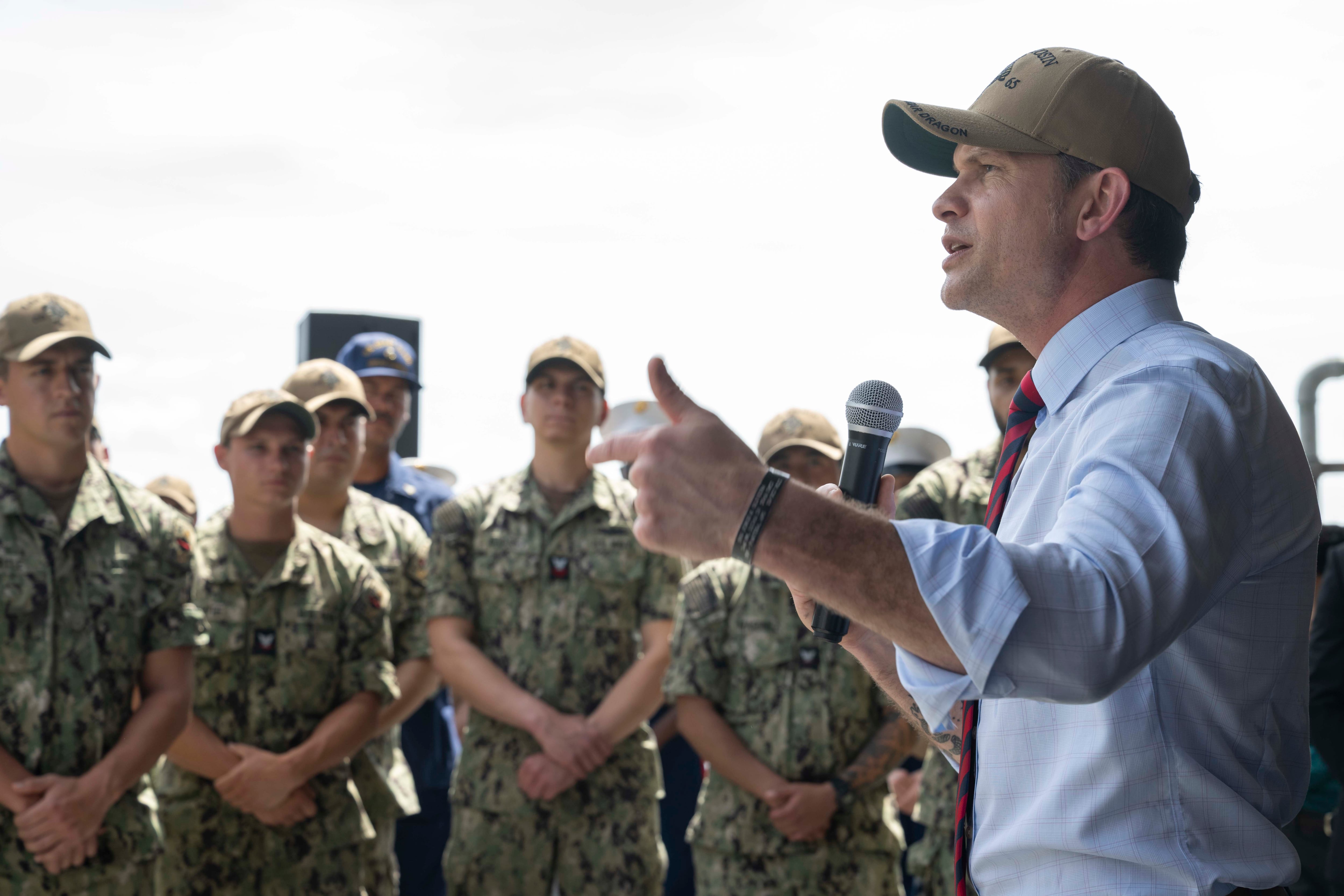NAVAL STATION NORFOLK, Virginia. — -- Wasp is back in the fight.
The 27-year-old gator, which last deployed in 2004, got underway Saturday morning as part of an 4,000-strong Amphibious Ready Group that includes dock landing ship Whidbey Island and amphibious transport dock San Antonio. The trio will carry the 22nd Marine Expeditionary Unit out of Camp Lejeune, North Carolina, on a planned six-month pump to 5th Fleet, where ARG commanders fully expect to tangle with ISIS.
Though among the oldest in the fleet (all three are first-of-class), the ships carry some of the newest sailors and systems — -- and a palpable readiness.
"This team is ready," said Capt. Byron Ogden, who commands the ARG as well as Amphibious Squadron (PHIBRON) 6. "We've been put through the paces, we've gone through a very extensive training cycle, and have hit the mark time and time again. I have the utmost faith and confidence in every one of those sailors and Marines on all three of these mighty warships that we will do our nation's bidding."
The commodoreHe reiterated the flexibility of his team, and the likelihood its skills will be put to the test in a wide variety of missions and locations. Disaggregated operations have been a hallmark of work ups. Ogden said he fully expects to disperse different leadership teams to the appropriate ships to provide "the right level and scalable force necessary to accomplish the desire task."
In that light, the MEU placed significant emphasis on building "a very strong relationship" with special operations forces, and even enabled a real-world MARSOC mission with cryptologic linguist support, Col. Todd Simmons, MEU commander, told Marine Corps Times days before departure. The Marines are well prepared for the likelihood of disaggregated ops, he said, which has become increasingly common for ground forces. The Corps has been pushing the company landing team concept, and has tested the integration of artillery in direct support of such a team. A prime example is Task Force Spartan. Its roughly 170 Marines remained in Iraq after the 26th MEU's April departure, and didn't return to Camp Lejeune until June 3. The detachment stayed in country to man the guns of a firebase near Makhmour in northern Iraq until U.S. Army artillery could provide relief.
The MEU also has some new items in the kit. Notably, it will be the first to deploy with the MQ-21 Blackjack unmanned aerial vehicle. It entails one system but the MEU will carry five vehicles. Though it is a Marine Corps program of record, the UAV is certain to provide maritime security for the ships, especially as they transit challenging and contested waters.
Moments before the ship set sail, it's skipper noted the emotion and excitement within her aging gray hulls.
"This crew has worked very, very hard over the last year and a half to get this ship ready to go back into the fight," said Capt. Andy Smith, who took Wasp's helm two months ago after fleeting up from the XO's seat. "They are very excited to go do the nation's business, and do what they joined the Navy to do — -- see the world."
The majority of crew members are on their first deployment, and — most were not in the Navy when Wasp last deployed. Still, a primary focus has been the shift in mindset from Fleet Week to forward deployed. A crummy 1980s-era advanced combat direction system -- — and an unwillingness by the Navy to make costly upgrades — -- all but shelved Wasp. For a decade, she was relegated to goodwill port visits and used as a gaining platform. As such, assignment to this gator has long meant little time at sea. Smith described Wasp as "basically a pre-commissioning crew on a 27-year-old ship."
But the amphibious assault ship came out of the shipyard in late 2014 after an extensive maintenance availability. Adjustments were made to accommodate operational testing of the Joint Strike Fighter. Further work was done to meet the demand that would be faced in preparation for and execution of a forward deployment to the Middle East.
The ship received upgrades to the Ship Self Defense System MK 2, SPQ-9B, MK 57 NATO Sea Sparrow Missile System, and Consolidated Afloat Networks and Enterprise Services.
In addition, significant maintenance included extensive repair of the cargo weapons elevator and boilers; repair/replace of tanks, waterborne shafting, and stern tube seal; preservation of underwater hull, uptake/intake, freeboard, and well deck overhead; and replacement of 6,000 feet of CHT piping as well as the main condenser expansion joint.
The blue-green team has spent much of the year busting off rust and getting everything aligned. Leading the task is Lt. Cmdr. Joe Towles. He reported aboard two years ago as the main propulsion assistant and fleeted up to chief engineer, or CHENG, in November. The engineering plant wasn't much of a was little to no problem, the mustang said. Though short, the ship's sporadic deployments kept main propulsion up and running. The real challenge came with large numbers of people came aboard, which proved more problematic for the auxiliary and electrical plants.
The MEU is comprised of Battalion Landing Team 1st Battalion, 6th Marines, Combat Logistics Battalion 22, Marine Medium Tiltrotor Squadron 264 (reinforced) , and the MEU Headquarters Command Element. Additional embarked units include Navy Beach Group (NBG) 2 with detachments from Assault Craft Unit 2, ACU 4, Beachmaster Unit 2, Tactical Air Control Squadron 22, Fleet Surgical Team 2, and Helicopter Sea Combat Squadron 22.





